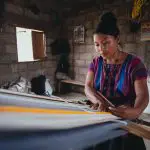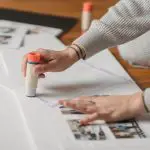Do you know that the way you join fabric can significantly impact the quality of your sewing projects? Understanding the art of fabric joining is crucial for achieving flawless results. From ensuring seamless seams to selecting the right joining technique, mastering fabric joining is the key to perfecting your sewing endeavors.
In this guide, you'll explore the importance of proper fabric joining, learn about common fabric joining techniques, discover tips for achieving seamless joins, and explore troubleshooting fabric joining issues. Whether you're a seasoned seamstress or an aspiring sewing aficionado, honing your fabric joining skills will elevate the craftsmanship of your creations.
Key Takeaways
- Proper fabric joining is essential for achieving professional-looking sewing projects.
- Matching the textures of the fabrics being joined is crucial to avoid puckering or uneven pulling.
- Using the appropriate stitch type for the fabric can make a substantial difference in the outcome.
- Paying attention to fabric texture, stitch quality, and alignment can elevate the quality and professionalism of your work.
Importance of Proper Fabric Joining
Joining fabric properly is crucial for achieving professional-looking sewing projects. This attention to detail will elevate the overall quality of your project.
When considering fabric texture, it's essential to match the textures of the fabrics being joined. For example, if you're joining two fabrics with different textures, such as a smooth cotton and a textured tweed, the seam may pucker or pull unevenly if not handled carefully.
Additionally, stitch quality plays a significant role in proper fabric joining. Using the appropriate stitch type for the fabric can make a substantial difference in the outcome. For instance, sewing a delicate silk fabric with a straight stitch might cause it to pucker, whereas using a fine, narrow zigzag stitch could create a smoother, more professional-looking seam.
Understanding the impact of fabric texture and stitch quality on proper fabric joining will enable you to master the art of creating seamless and polished sewing projects. By paying attention to these details, you can elevate the quality of your work and achieve a more refined and professional finish.
Common Fabric Joining Techniques
You need to understand the various common fabric joining techniques to ensure that your sewing projects achieve a professional finish and lasting quality.
When it comes to stitching techniques, using a straight stitch is the most common method for joining fabric pieces together. However, for more strength and durability, a zigzag stitch can be utilized, especially for stretchy or knit fabrics.
Hemming methods are crucial for achieving neat and polished edges. Options include blind hems, rolled hems, and topstitched hems, each offering a different look and finish to your sewing projects.
Fabric fusion allows for joining fabrics without visible stitching. This technique is ideal for delicate fabrics or when a seamless look is desired. It involves using fusible webbing or adhesive to bond the fabrics together.
Seam finishing is essential for preventing fraying and ensuring the longevity of your sewing projects. Techniques such as serging, zigzag stitching, and pinking can be employed to finish raw fabric edges and seams neatly.
Mastering these common fabric joining techniques will elevate the quality of your sewing projects and provide a professional touch to your creations.
Choosing the Right Fabric for Joining
When choosing the right fabric for joining, consider the weight and drape of the fabric to ensure a cohesive look and feel in your project.
Additionally, coordinating colors and prints will help create a harmonious and visually appealing final product.
Keep these points in mind as you select the fabric for your sewing project to achieve the best results.
Fabric Weight and Drape
To achieve the best results when joining fabric, consider the weight and drape of the fabric you choose.
Fabric drape plays a crucial role in how your project will hang and flow. Different stitching techniques can be used to manipulate the drape of the fabric, such as gathering or pleating to create volume or using understitching to control the way the fabric lays.
When it comes to weight distribution, understanding how the fabric will behave is essential. Some fabrics may require additional support or structure to achieve the desired outcome, while others may need careful handling to avoid distortion. Fabric manipulation techniques, like adding interfacing or using specific seam finishes, can help maintain the fabric's integrity.
Color and Print Coordination
Considering the weight and drape of your fabric is essential when coordinating colors and prints for joining, as it directly impacts the overall look and feel of your sewing projects.
When it comes to print selection, opt for prints that share at least one color with the main fabric to create a cohesive look. Additionally, consider the scale of the print in relation to the size of the project and the wearer's body.
Pattern matching is crucial for a professional finish. Aligning prints at the seams and ensuring continuity across joins will elevate the quality of your work. Take the time to carefully match patterns, ensuring they flow seamlessly from one piece to another.
This attention to detail will result in a polished and harmonious final product.
Tips for Achieving Seamless Joins
Achieve seamless joins by carefully aligning your fabric edges before stitching. Fabric alignment is crucial for ensuring clean and professional-looking seams. When joining fabrics, take the time to match up the edges precisely, ensuring that they're parallel and even. This attention to detail will greatly enhance the stitch quality and overall appearance of your sewing projects.
To achieve impeccable stitch quality, start by pinning or basting the fabric pieces together before sewing. This will help to maintain the alignment and prevent any shifting during the stitching process. Additionally, using the appropriate sewing machine settings and needle for your fabric type can significantly impact the quality of your stitches.
Another tip for achieving seamless joins is to press the fabric edges before stitching. Pressing creates crisp, flat seams and helps the fabric pieces to lay smoothly against each other, resulting in a clean and polished finish.
Troubleshooting Fabric Joining Issues
When encountering fabric joining issues, ensure that your fabric edges are properly aligned before stitching to prevent potential problems. Proper alignment sets the stage for successful fabric joining.
Here are some troubleshooting tips to help you master the art of fabric joining:
- Stitch Quality: Examine the stitch quality to ensure that it's consistent and even throughout the fabric joining process. Uneven or skipped stitches can weaken the seam and lead to fabric joining issues.
- Fabric Tension: Pay close attention to the tension of the fabric as you sew. Uneven tension can cause puckering, stretching, or distortion, which can affect the quality of the fabric join.
- Needle and Thread Compatibility: Ensure that the needle and thread are suitable for the fabric you're working with. Using the wrong needle or thread can lead to stitching issues, affecting the fabric join.
- Pressing and Finishing: After joining the fabric, press the seam to set the stitches and ensure a smooth, professional finish. Inadequate pressing can result in an unsightly fabric join.
Mastering these troubleshooting techniques will elevate the quality of your fabric joins and contribute to the overall success of your sewing projects.
Advanced Fabric Joining Methods
Ready to take your fabric joining skills to the next level?
Seamlessness in fabric joining and precision with fabric joins are key points to consider when exploring advanced fabric joining methods.
These techniques can elevate the quality and professional finish of your sewing projects.
Seamlessness in Fabric Joining
To achieve seamless fabric joining in your sewing projects, consider employing advanced fabric joining methods. These techniques elevate the quality of your work, showcasing your mastery in sewing.
Here are some advanced fabric joining methods to help you achieve seamlessness:
- French Seam: This professional technique encases raw edges for a clean finish.
- Flat-Felled Seam: Known for its durability, this seam finishing method is commonly used in denim and sportswear.
- Bound Seam: This decorative finish adds a stylish touch to your projects while also ensuring durability.
- Lapped Seam: By overlapping fabric edges and securing them in place, you can achieve a smooth and polished look.
Mastering these advanced fabric joining methods will elevate the quality of your sewing projects, resulting in seamless and professional-looking outcomes.
Precision With Fabric Joins
For achieving precise fabric joins in your sewing projects, employing advanced fabric joining methods is crucial. Stitch accuracy and fabric alignment are fundamental for ensuring seamless edges and a strong fabric connection.
To elevate your sewing prowess, consider using techniques such as hand basting, flat felled seams, and French seams.
Hand basting allows for meticulous alignment before machine stitching, ensuring that your fabric pieces are perfectly matched.
Flat felled seams provide durable and neat finishes, perfect for joining heavy or medium weight fabrics.
French seams, on the other hand, encase raw edges for a clean and professional look, ideal for lightweight fabrics.
Frequently Asked Questions
Can Joining Fabric Affect the Drape and Movement of the Finished Garment?
Joining fabric impacts garment movement. Different fabric joining techniques, such as seams or pleats, affect how the garment drapes and flows. Mastery of these techniques ensures your sewing projects have the perfect drape and movement.
Are There Any Special Considerations for Joining Stretch or Knit Fabrics?
When working with stretch fabrics, consider using a stretch stitch or a narrow zigzag stitch to maintain flexibility. For knitted fabrics, use a ballpoint needle and stabilize seams to prevent stretching or distortion.
How Does Fabric Joining Impact the Overall Durability and Longevity of a Sewing Project?
Joining fabric impacts durability and longevity. Your choice of fabric affects the project's resilience. Proper stitching techniques and maintenance also play a crucial role. Mastering these elements ensures your sewing projects stand the test of time.
Can Fabric Joining Techniques Be Used to Create Decorative Seams or Details on a Garment?
You can elevate your sewing projects with decorative stitching and embellishment techniques. By mastering fabric joining, you'll have the foundation to create intricate seams and intricate details, adding a professional touch to your garments.
Are There Specific Fabric Joining Methods That Work Best for Different Types of Fabric, Such as Delicate or Sheer Fabrics?
When working with delicate or sheer fabrics, it's crucial to use the right fabric joining techniques. For delicate fabrics, consider using French seams, while with sheer fabrics, opt for methods like flat felling or hand-rolled hems for best results.
- Is Organza Soft or Stiff? - April 23, 2024
- Is Organza More Expensive Than Silk? - April 23, 2024
- What Is Organza Vs Chiffon? - April 23, 2024





